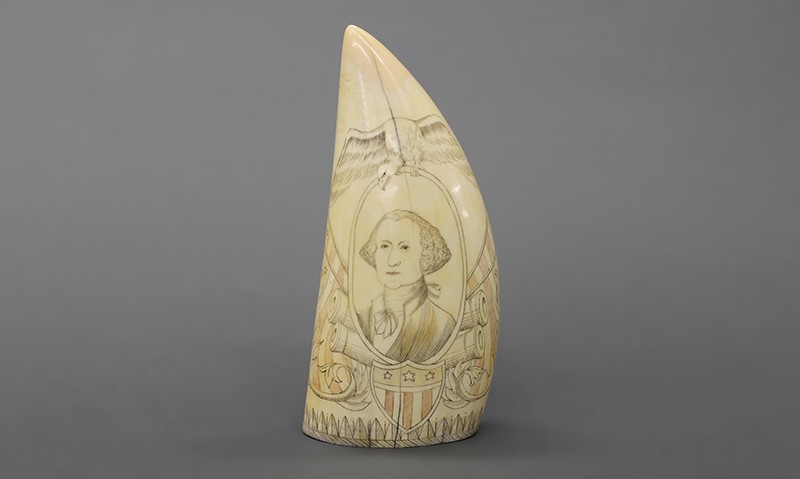 |
Scrimshaw of George Washington, early 19th Century
Unknown artist (American); North America
Sperm whale ivory and ink; 5 1/4 x 2 1/2 x 1 1/2 in.
2011.25.56
Gift of Dr. and Mrs. Burton W. Fink |
New England, Old American Carvings
Independence Day is the annual celebration of all things American. For most, revelries might include fireworks, barbeque, throwing taxed tea into Boston Harbor, or any number of other explosive and delicious ways to party. It makes perfect sense that there would be so many ways to celebrate too, because over the course of America’s history being patriotic has taken many forms. One of these curiously arose from the New England whaling industry of the mid to late 19th Century, where symbols such as our founding fathers, American flags, and crested eagles were scrimshawed into whale bone and ivory. Here we look closely at the medium and designs of three patriotically decorated scrimshaw pieces in the Bowers’ collections.
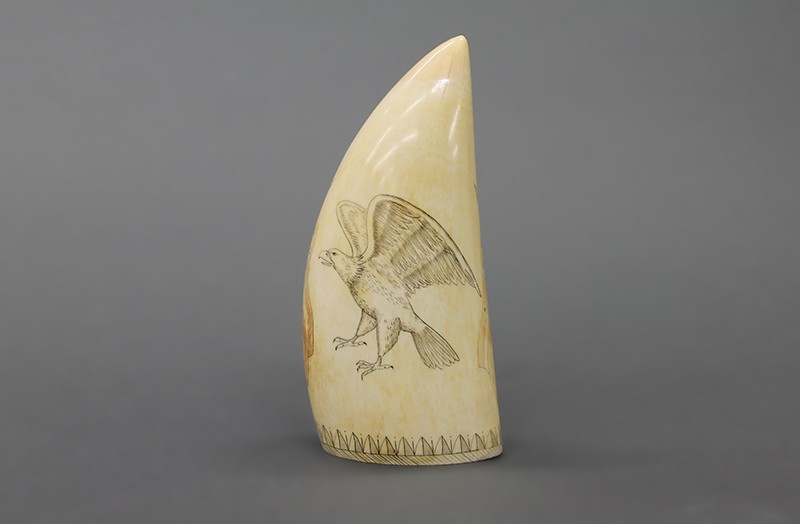 |
| Detail of 2011.25.56 |
Yankee Doodle
We begin this post where our own nation began: with none other than George Washington. Washington is by far the most commonly depicted founding father in scrimshaw, likely due to his popularity as a non-partisan hero of the United States. A carving’s subject matter could come from a variety of sources, but whalers generally drew on the works of others rather than creating original designs. Tearing pages from books, pinning them over scrimshaw, and using illustrations as a guide was a common practice of less-talented artists, but we can see that this was not the case for the incredibly talented anonymous carver of this tooth. He may have used an image of Washington for reference—most likely one of the famous Gilbert Stuart portraits from the closing years of the 18th Century—but the design is carved in free-form. The strokes are shallow and well intentioned, and we see examples of advanced techniques such as the cross-hatching on the underside of the cannons and where Washington’s jacket meets the ovoid frame he sits in. About as much patriotic imagery is carved onto the tooth as is possible. This abundance is perhaps most simply evidenced by there being not one, but two bald eagles, one of which is apparently agitated about defending the tooth’s rear. All-together the imagery indicates either the carver’s overflowing patriotism or a good business sense in understanding that his target audience would have that same overflowing sense of patriotism.

|
|
Decorated Porpoise Jaw, 19th century
Unknown artist (American); North America
Porpoise jaw and ink; 2 x 4 3/4 x 15 in.
2011.25.120
Gift of Dr. and Mrs. Burton W. Fink |
Sense of Porpoise
It is with this object that medium becomes an interesting note in this post. Most scrimshaw was done using whale parts, usually teeth or bone, but the curious shape of this piece comes from the jawbone of a porpoise. ‘Whaling Industry’ is generally the term used to describe the hunting expeditions of New England mariners, but whales were not the only catch that whalers were on the prowl for. With porpoises, an oil which was ideal for lubricating the delicate components of clocks and other measuring implements could be extracted from the same bone we see carved here. The patriotic designs on this jaw were all done with stippling, rather than the far more proficient carving of the first piece. With a close inspection, the reason for the lower quality of this piece quickly becomes clear: this jaw was used for practice. Two almost-identical, incomplete eagles contest the same space much in the same way an improperly stamped document might receive a second stamping. For them to be so similar to one another, the same overlaid page technique described above would have been used. Far from being the only technique practiced here, the opposite side of the jawbone features a shakily-exacted example of the artist working freehand. This small doodle provides a better explanation than any critical review could as to why the carver needed the practice.

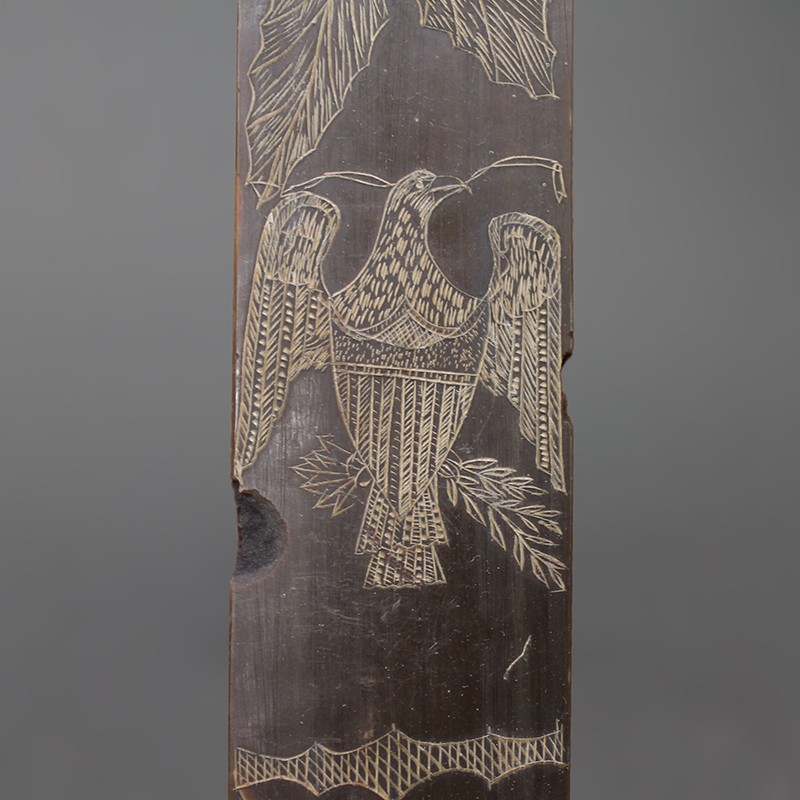 |
Detail of Busk, 19th Century
Unknown artist (American); North America
Whale baleen; 13 1/4 x 1 5/8 in.
2011.25.46
Gift of Dr. and Mrs. Burton W. Fink |
Busk Your Chops
In addition to patriotic fervor, the last object in this post is also an interesting study in medium. It is a busk made of polished whale baleen—a similar substance to what our fingernails are made of used for filter-feeding. Busks were structural aides of corsets. Made of any lightweight, semi-flexible material available, they were inserted into pockets of corsets and usually secured with ties. The imagery of this busk is surprisingly complex, stemming from a time when politics and religious iconography were often interwoven. A lack of documentation means we are forced to postulate, but if this busk was made following the Civil War it might explain the dove with the olive branch—a ubiquitous symbol of peace. Where we do see an indisputable symbol of patriotism is the eagle near the bottom of the busk. This design clearly references the great seal of the United States, though it has interestingly been reversed in both its facing and which claw bears the 13 arrows and which bears the olive branch. The reason for this mirroring is a mystery, but it too could have resulted from a traced carving using an overlaid sheet.
Text and images may be under copyright. Please contact Collection Department for permission to use. References are available on request. Information subject to change upon further research.




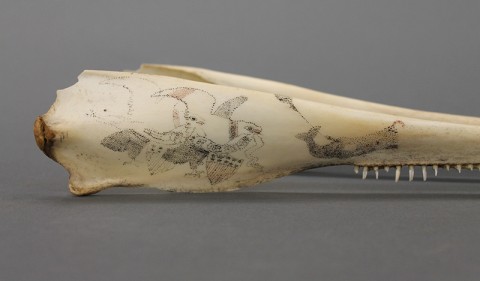
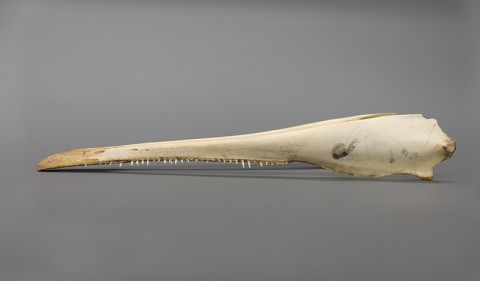
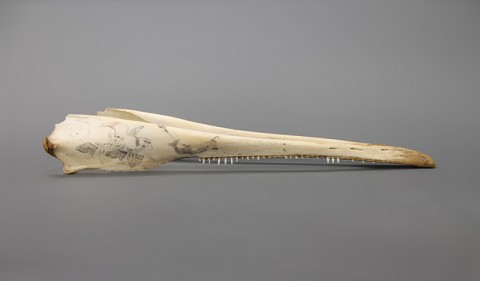

Comments